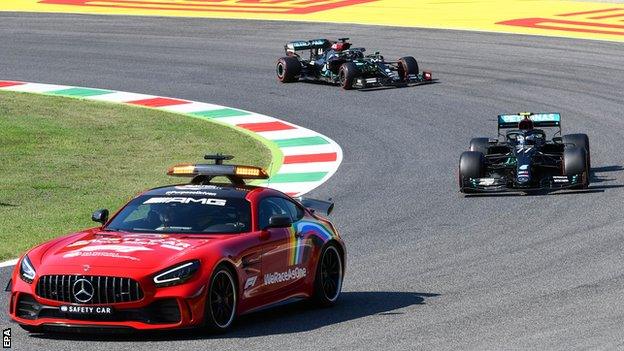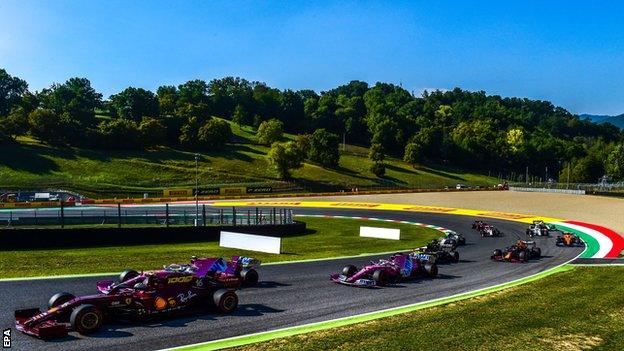Tuscan Grand Prix: Lewis Hamilton leads criticism of restart approach after huge crash
- Published

Hamilton highlighted over team radio the dangers of turning the Safety Car lights off late
Lewis Hamilton criticised Formula 1 officials for endangering drivers with their approach to restarts behind the safety car after a chaotic Tuscan Grand Prix.
The Mercedes driver won the race, to take the 90th victory of his career and move within one of Michael Schumacher's all-time record, but the event was overshadowed by a series of controversial incidents, including two race stoppages.
Hamilton said the way governing body the FIA handled a safety car restart, which led to a multi-car pile-up that took four cars out of the race, "put people at risk so maybe they need to rethink that".
The top three drivers all expressed the same opinion about the FIA's decision to delay the point at which the safety-car lights are extinguished, which defines the moment from which the leader can control the pace.
Hamilton, team-mate Valtteri Bottas and Red Bull's Alexander Albon all said the decision to do so at the last corner left the leader with no option but to back up the field until he reached the start-finish line, where racing can start, to reduce the risk of being passed.
At Mugello, this led to confusion among the drivers behind.
Haas driver Kevin Magnussen slowed down as he approached the line, reacting to cars in front. Williams' Nicholas Latifi took avoiding action and, unsighted until the last second, Alfa Romeo's Antonio Giovinazzi rammed into the back of Magnussen's car. McLaren's Carlos Sainz then hit both Latifi and Giovinazzi, who came close to rolling, before his car settled back on to the track.
Hamilton said: "It's absolutely not Valtteri's fault at all. It's the decision makers. I don't know who.
"They have been been moving the switching off the safety car lights later and later. We are out there fighting for position. Especially when you earn a position like Valtteri earned the position of being in the lead.
"Obviously they are trying to make it more exciting - but today was a little bit over the limit perhaps. But he [Bottas] did exactly what anyone would do."
Why did Bottas have to drive like that?
The long straight at Mugello makes the leader vulnerable to being overtaken at a re-start if he simply accelerates off the last corner, because of the power of the slipstream. So he is forced into delaying starting racing until the last possible moment.
Bottas said Mercedes had raised their concerns about the potential for exactly this sort of incident before the race at Mugello. They had noted that the FIA had been delaying the safety car lights going off further at every instance over a series of support races during the weekend.
"Our team opened up the discussion this morning before the race that it is a bit of a concern here," he said. "But they said basically they are going to keep doing it because it is better for the show.
"We are allowed to race from the control line [the start-finish line], [a ruling] which has been been there for a while. The difference this year is they are putting the safety car lights off quite late so you can only build the gap pretty late on.
"So in the lead you try to maximise your chances and I'm not at all to blame for that. I was doing consistent speed until I went. Yes, I went late, but we start racing from the control line, not before that.
"So the guys behind who crashed because of that, they can look in the mirror. There is no point whining about it.
"I don't know who decides what happens with the safety cars, FIA or F1, but they are trying to make the show better by turning the lights later so you can't build the gap earlier and then go like corner before the race start down the main straight. Maybe it's time to think if that's right and safe to do so."
Albon added: "When you put the control line so far in front and then also leave the lights so late, it is pretty obvious where Valtteri is going to take off. He is going to take off as late as he can, and I imagine the midfield know where Valtteri is going to go and are also going to try to get a slingshot.
"Then if Valtteri doesn't go when they think he is going to go, that is when the concertina happens. It's dangerous but it's predictable as well.
"The top five were almost doing a double-formation start because we are all waiting for the take off. It's dangerous. Tracks like this are always going to be difficult with the long straights. But definitely something could have been done better."
Race stewards issued a warning to 12 drivers about their conduct behind the safety car - in addition to the four involved in the accident, Albon, Daniil Kvyat, Lance Stroll, Daniel Ricciardo, Sergio Perez, Lando Norris, Esteban Ocon and George Russell.
Drivers' accusations are 'offensive'
The incidents at Mugello came a week after a mixed-up race at Monza where two decisions - closing the pit lane while the safety car was out, and having a standing re-start after a red flag - led to an upset win for Alpha Tauri's Pierre Gasly.
Both decisions are within the regulations but had previously been rarely seen.
They also come in the wake of F1 managing director Ross Brawn making it clear he was still determined to introduce a trial for reverse-grid sprint races in place of qualifying, an idea likened by Mercedes F1 boss Toto Wolff to reducing F1 to something akin to WWE wrestling.
Hamilton was asked whether he felt safety was being compromised for the sake of better entertainment.
"I don't know," he replied. "I need to think about it and I don't want to overstep the mark.
"I know the fans were excited with the last race with the re-start and everything and it seems if there is a piece of paper on the track they are going to put the red flag out and do a re-start and I can understand why and that it's exciting.
"Ultimately these races can get boring when everyone strings out and there are such big gaps between everyone.
"They do it in Nascar. They put out the yellow flag all the time and safety cars, whatever, all the time to keep the race exciting,
"But they need to take into account the safety aspect. Today was not particularly safe with the re-start. You could almost see that coming. I am sure they will learn from it and we'll move together as a sport."
Senior figures say this progressive shift in approach has been triggered by the perceived appeal of re-starts at the Azerbaijan Grand Prix, where the spot at which the safety car switches off its lights is shortly before a massively long straight that promotes slipstreaming.
The drivers' accusations were put to race director Michael Masi. He said the drivers "can criticise all they want" but that the "distance to control line was not dissimilar to a lot of other venues". And he pointed out that there had been a similar situation in a Formula 3 race over the weekend and those drivers "navigated it quite well".
He added that there was "no need to review the safety-car re-start rule".
And asked whether he was spicing up the show at the expense of safety, Masi said: "Absolutely not. From an FIA perspective, safety is paramount. Full stop. End of story. In my capacity as the race director and safety delegate, it's point blank that's where my role sits, the sporting integrity and safety. Anyone that says otherwise is quite offensive personally."
The F1 drivers, though, are obviously not happy about it, and Masi can expect some questions about it over the coming days, and in the drivers' briefing at the next race in Russia on 25-27 September.
Mugello wins admirers

Fans were quick to praise the picturesque Tuscan circuit
Whatever one's feelings about the handling of this particular issue, there is no doubt that Mugello lived up to its reputation on its F1 debut.
It owes its grand prix to coronavirus, which has forced F1 to create a mainly European calendar after the cancellation of the first 10 races of the season, and be creative in its search for venues.
Mugello has long been held in awe by the cognoscenti but few F1 drivers had until this weekend had a chance to experience it. It did not disappoint.
It looks gorgeous, nestled in the landscape of Tuscany, and it provides an extreme challenge to the drivers. No corner is taken slower than 80mph and some of the combinations are right up with the very best in the world, particularly the flat-out section of Turns Six, Seven, Eight and Nine, taken at more than 170mph in qualifying.
"I love it," Hamilton said. "It was one of the toughest tracks to drive. It's a fantastic circuit and I don't think it was too dangerous. It's more old-school with the run-off areas and gravel and I hope they don't change that and I would love to come back."
More than that, Mugello's demands helped create the drama of the race.
Fears that overtaking would be too difficult proved unfounded because of the long straight, and the banked first corner led to some excellent moves, including the one with which Hamilton took the lead at the second start and a couple of beauties by Albon in his recovery drive, on Racing Point's Sergio Perez and Renault's Daniel Ricciardo.
It is also extremely tough on tyres, much like Silverstone and Spa, so it was perhaps no surprise that Bottas ran into the same problems with extreme wear and vibration that had led to failures on both Mercedes at the British Grand Prix.
Forewarned, Mercedes were able to take action this time to mitigate the problem, but their tyre concerns effectively neutralised the race between Hamilton and Bottas once they emerged, and the result came down to who handled the starts best.
Bottas took Hamilton at the first. Hamilton re-passed at the second. And when Bottas was slow away at the third, Hamilton had it sealed.
Fifty-five points clear in the championship as the season passes half-distance, that seventh title is getting ever closer.
The record of wins will come first and, after six victories in nine races, neither is too far away.

Nightlife and coronavirus: How will clubbing survive?
Jamie Oliver: Nine interesting facts about the famous chef
